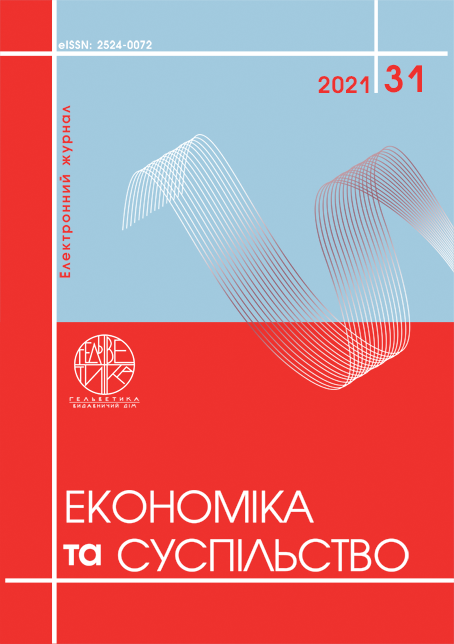STATE REGULATION OF CONCESSIONS AS AN ELEMENT OF NATIONAL ECONOMIC INFRASTRUCTURE DEVELOPMENT
Abstract
The article considers the directions of state regulation of the concession as an element of infrastructure development of the national economy. Methods of state regulation of infrastructure development through a set of regulatory tools are substantiated. The interpretation of the concepts – "public-private partnership", "concession" is studied. It is proved that the undisputed leader in the value of implemented public-private partnership projects in European markets is the sphere of infrastructure, and in quantitative terms – the sphere of education. At the same time, as can be seen from international practice, the most common form of public-private partnership projects is a concession. Amendments to the legislative support of the concession mechanism made it possible to clearly define the criteria for evaluating bids: the internal rate of return, the reliability of the financing mechanism, the cost of investment, the amount of possible state support. The possibility of a wide range of state support instruments is enshrined in law. The main role of the state in the development of infrastructure in the modern economy is to identify benefits for the end user, assess the socio-economic effects of infrastructure development and develop effective tools for the strategic perspective. The latter include: adoption of strategic infrastructure decisions by companies with state participation, regulation of monopoly sectors in terms of infrastructure development, formation of inter-level national and regional instruments for effective infrastructure development, formation of clear and transparent institutions in existing and new transport markets. Infrastructure should not be created for the sake of infrastructure, ie the main emphasis should not be on quantitative indicators – kilometers of new roads, railways, increasing the capacity of seaports and so on. The latest infrastructure in general and each project in particular – should be tied to specific results in terms of user satisfaction and contribution to achieving the goals and specific objectives of socio-economic development of the country. The feasibility and priority of transport projects and regulatory changes should be assessed through the prism of contributing to accelerating economic growth and concrete positive changes for users. This does not mean that all transport projects should be decided solely in terms of stimulating economic growth – many projects have purely technological or social aspects. But the highest priorities should be those that increase the productivity of the economy, its investment attractiveness, make a significant contribution to the development of human capital.
References
Кондратьев В. Б. Инфраструктура как фактор экономического роста. URL: http://www.perspektivy.info/rus/ekob/infrastruktura_kak_faktor_ekonomicheskogo_rosta_2010-11-10.htm. (дата звернення: 25.04.2021)
Клинова М. Глобализация и инфраструктура: новые тенденции во взаимоотношениях государства и бизнеса. Вопросы экономики. 2008. № 8. С. 78–90.
Про державно-приватне партнерство : закон України: [прийнято Верховною Радою України 01.07.2010 р. № 2404-VI]. URL: http://zakon4.rada.gov.ua (дата звернення: 25.05.2021)
Закон України «Про концесії» : від 16.07.1999 р., № 997– XIV. URL: http://zakon3.rada.gov.ua/laws/show/997-14 (дата звернення: 11.05.2021)
Господарський кодекс України від 16.01.2003 № 436-I. URL: https://zakon.rada.gov.ua/laws/show/436-15 (дата звернення: 11.05.2021)
Варнавский В. Г. Партнерство государства и частного сектора: формы, проекты, риски. РАН ; Институт мировой экономики и международних отношений. Москва : Наука, 2005. 315 с.
Катерина Максимчук Що стоїть на заваді концесіонерам? URL: https://yur-gazeta.com/publications/practice/derzhavnoprivatne-partnerstvo/shcho-stoyit-na-zavadi-koncesioneram.html (дата звернення: 11.05.2021)
Офіційний сайт Міністерства економічного розвитку та торгівлі України. URL: http://www.me.gov.ua/Documents/Detail?lang=uk-UA&id=fc354c59-cb8f4660-b7d5-1acdf35f0ab7&title=InformatsiiaSchodoStanuZdiisnenniaDerzhavnoprivatnogoPartnerstva (дата звернення: 15.05.2021)
Півтора роки тому запрацював закон про концесію. Що це змінило? URL: https://www.epravda.com.ua/publications/2021/04/12/672860/ (дата звернення: 20.05.2021)
Kondratev V. B. Ynfrastruktura kak faktor эkonomycheskoho rosta. URL: http://www.perspektivy.info/rus/ekob/infrastruktura_kak_faktor_ekonomicheskogo_rosta_2010-11-10.htm.
Klynova M. (2008) Hlobalyzatsyia y ynfrastruktura: novыe tendentsyy vo vzaymootnoshenyiakh hosudarstva y byznesa. Voprosy ekonomyky. № 8. S. 78–90.
Pro derzhavno-pryvatne partnerstvo : zakon Ukrainy: [pryiniato Verkhovnoiu Radoiu Ukrainy 01.07.2010 r. № 2404-VI]. URL: http://zakon4.rada.gov.ua
Zakon Ukrainy «Pro kontsesii» : vid 16.07.1999 r., № 997–XIV. URL: http://zakon3.rada.gov.ua/laws/show/997-14
Hospodarskyi kodeks Ukrainy vid 16.01.2003 № 436-I. URL: https://zakon.rada.gov.ua/laws/show/436-15
Varnavskyi V. H. (2005) Partnerstvo hosudarstva y chastnoho sektora: formы, proektы, rysky. RAN ; Ynstytut myrovoi эkonomyky y mezhdunarodnykh otnoshenyi. M.: Nauka, 315 s.
Kateryna Maksymchuk Shcho stoit na zavadi kontsesioneram? URL: https://yur-gazeta.com/publications/practice/derzhavnoprivatne-partnerstvo/shcho-stoyit-na-zavadi-koncesioneram.html
Ofitsiinyi sait Ministerstva ekonomichnoho rozvytku ta torhivli Ukrainy. URL: http://www.me.gov.ua/Documents/Detail?lang=uk-UA&id=fc354c59-cb8f4660-b7d5-1acdf35f0ab7&title=InformatsiiaSchodoStanuZdiisnenniaDerzhavnoprivatnogoPartnerstva
Pivtora roky tomu zapratsiuvav zakon pro kontsesiiu. Shcho tse zminylo? URL: https://www.epravda.com.ua/publications/2021/04/12/672860/


